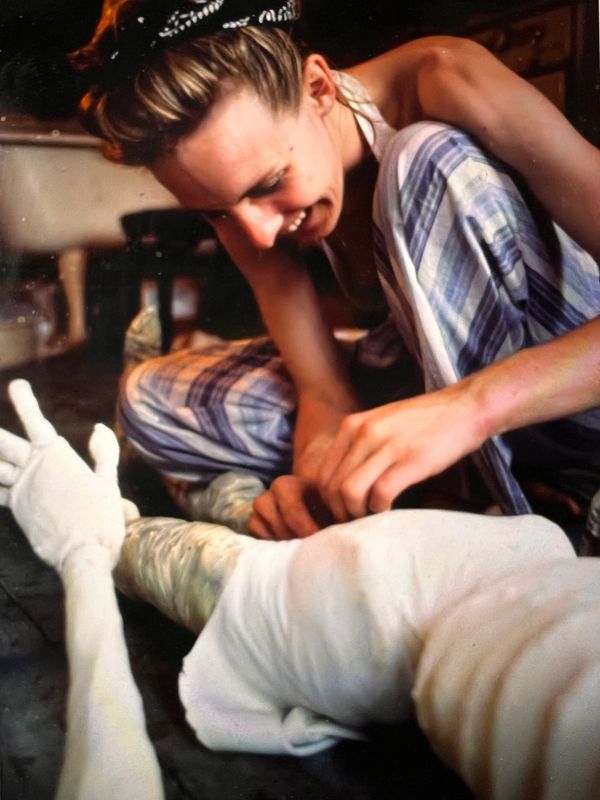

Greer Lankton

Greer Lankton Bio
Greer Lankton (1958 – 1996) was one of the most significant artists to have taken part in the revolutionary art scene of New York City’s East Village during the 1980s. Lankton grew up in Park Forest, IL, where she graduated a year early from high school to attend the Art Institute of Chicago from 1975 to1978. That year she moved to New York City and received her BFA from Pratt Institute in 1981. By then Lankton had secured her reputation as a leading figure in the social ferment of NYC in the 1980s through her visceral doll sculpture, and now lesser-known performances and minimalist soft sculpture.
Lankton’s drawings are frequently compared to that of the expressionist Egon Schiele and her dolls and their photographic portraits, to that of surrealist Hans Bellmer. Yet her experimental and multimedia work are located within a history of transfeminism, avant-garde performance and even pop-art, while at the same time is equally situated within a neo-punk canon and the Trash Trilogy of John Waters films - Pink Flamingos being her favorite.
Lankton’s exhibitions and performances included those at PS1, Club 57, Pyramid Club, Franklyn Furnace, Civilian Warfare Gallery, Hal Bromm and the Whitney Biennale, NYC. She also exhibited across the US and Europe, including the UK, Austria and the Venice Biennale, Italy. She exhibited her first full-scale installation artwork at the Mattress Factory Museum shortly before her untimely death in 1996.
-Mattress Factory Museum-
Could it Be Love by Greer Lankton
Greer Lankton’s iconic and startling doll sculptures as we have never seen them before: through her own eyes.
Magic Hour Press is proud to present the first monograph on the trans visionary artist Greer Lankton (1958–96), whose lifelike doll sculptures shocked 1980s New York. Lankton’s dolls, which she began making as a child and produced obsessively until her death at age 38, were a means to explore her fraught relationship with the human body. In the book’s 100 photographs, all shot by Lankton herself, these figures take on a life of their own, kvetching at a party, strolling along a beach, or lounging on a stoop in the East Village. Among this extraordinary cast of oddballs—usually femme, often freakish, always radiating a glamorous confidence—we find characters of Lankton’s own invention alongside well-known icons such as Divine, Coco Chanel, Andy Warhol and even Lankton herself.
Born in 1958 to a Presbyterian minister in Michigan, Greer Lankton moved to New York in 1978 and became a rising star of the downtown scene. There, her deviant elegance was immortalized in photographs by Peter Hujar, David Armstrong, and Lankton’s close friend Nan Goldin, who described her as “one of the luminaries of the East Village renaissance: beautiful, glamorous, wild and hysterically funny.” -Magic Hour Press-
Greer's Sketchbook Journal
Sketchbook, September 1977 is an early journal by
Greer Lankton written during her time as an art student at the School of the Art Institute of Chicago. It offers key insights into the artist’s mind before her move to New York in 1978, where she would go on to have a prolific career making lifelike dolls, theatrical sets, photographs, drawings, and paintings.
Containing drawings, behavioral diagrams, and occasionally confessional writing, the journal is a record of imagining the body and mind reconciled through transformation. In these pages, the nineteen-year-old turns an inquisitive, sociological eye toward the emotional landscape and somatic effects of her days recorded here—the time period leading up to her decision to undergo hormone treatment and gender-affirming surgery in 1979. Lankton reflects with raw vulnerability and keen self-awareness on critical questions of self-image, social perception, gender normativity, and human behavior.
-Primary Information-
Greer Lankton Archives
In July 2014, Greer Lankton’s family donated to the Mattress Factory a gift of art, personal papers, photographs, and related material, which they had saved throughout her life and which they had recovered after her death in 1996. An unfiltered view into the life and work of one of the most significant artists to have taken part in the revolutionary art scene in New York City’s East Village during the 1980s, the collection of thousands of items includes drawings and paintings, sculptures, sketchbooks, photographs, correspondence, personal journals, press clippings and more. These materials trace Lankton’s artistic development from childhood, studies at Pratt Institute, and exhibitions at downtown New York’s Civilian Warfare gallery, as well as her personal relationships (including those with artists such as Nan Goldin), gender reassignment surgery, and struggles with addiction and anorexia.
-Mattress Factory Museum-
Permanent Installation Mattress Factory Museum in Pittsburgh
“They're all freaks. Outsiders, untouchables. They’re like biographies, the kind of people you’d like to know about. Really interesting and fucked-up.”
Greer Lankton on her doll sculpture in an interview with Carlo McCormick in the East Village Eye, November
1984.
She exhibited her first full-scale installation artwork at the Mattress Factory Museum shortly before her untimely death in 1996.
-Mattress Factory Museum-
This website uses cookies.
We use cookies to analyze website traffic and optimize your website experience. By accepting our use of cookies, your data will be aggregated with all other user data.


